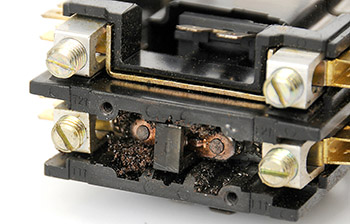Ants behaving badly
19th October 2013 Contactor failures are a common cause of air conditioner breakdowns. In parts of the world insects are increasingly responsible. In some states of the USA it has reached plague proportions, forcing manufacturers to act.
Contactor failures are a common cause of air conditioner breakdowns. In parts of the world insects are increasingly responsible. In some states of the USA it has reached plague proportions, forcing manufacturers to act.
It’s not unusual for air conditioning and refrigeration contractors here in northern Europe to come across spiders, insects or other bugs inside a condensing unit during the course of a service call. On rare occasions even a rodent (alive or dead) or nesting bird. It’s sometimes difficult to prove but the infestation may even be blamed for the breakdown – a rodent chewing through a cable, an insect shorting out contacts – but it is relatively rare. In parts of the US, however, insect infestation in air conditioning and refrigeration units is becoming a major problem prompting air conditioning manufacturers to find an answer.
Problems from invasive pests are said to cost Americans nearly $20bn annually. Ants are a major culprit and air conditioning units are one of the prime targets. Figures are difficult to find but in 2001, in Texas alone, fire ant damage to electrical equipment was put at $146.5m per year.
The main problem is that ants appear to be attracted to electrical equipment. It is still a controversial subject but some scientists suggest they sense the magnetic field surrounding live wires, others that they are attracted to the heat from the resistance in the wires.
Either way, the problem appears to be increasing with the arrival in the Gulf Coast states of the USA of a new ant on the block. The curiously named Raspberry (aka tawny) crazy ant is so named not for the fact that it is red (it isn’t) but after Tom Raspberry the far-from-crazy exterminator who first identified the problem with this little critter in the early 2000s. And crazy? This popular name apparently comes from the ant’s erratic foraging movements rather than any definable malfunction of its admittedly limited mental faculties.
Invasive

An invasive species, the crazy ant comes from Brazil and Argentina. It first turned up in Houston, Texas, but is now found all over Southeast Texas through Florida and Mississippi.
Unlike America’s common fire ant, the crazy ant doesn’t sting and at only 3mm long is tiny by comparison. But it breeds in huge numbers and is not territorial. Separate colonies live quite happily side-by-side but due to their overwhelming numbers, native species are often forced out.
Another distinct and significant difference is that the crazy ant does not build nests as such, instead seeking out pre-existing cavities. With its small size, liking for small spaces and, seemingly, a penchant for electrical installations it is no surprise that items like contactors on air conditioning units have become a favourite hide-out and ultimate place of electrocution.
To compound the problem, when an ant is electrocuted it gives out an alarm pheromone which attracts even more ants to the scene. As a result, engineers arrive on site to find air conditioning controls literally packed with dead ants.
In one reported case in Waco, Texas, the ants took over an apartment building, quickly spreading to 90 out of 150 air conditioning units.
The attraction to electrical equipment appears to be a commonly accepted phenomenon by scientists.
“Virtually everyone we have talked to who has them mentioned having some type of electrical issue as a result of their infestations,” Joe MacGown, an ant expert at Mississippi Entomological Museum, told the Cooling Post.
But are they actually attracted to electrical fields?
“Although I don’t know of a definitive study that has specifically documented this phenomenon for crazy ants, I would say that yes, they are likely attracted to electrical fields. This has been documented in other ant species, and based on the widespread problem with crazy ants and electricity, this makes sense. Additionally, it might also have something to do with the sheer numbers of these ants. I mean, when you have them, you have them everywhere. So, that would include inside electrical components as well.”

Bug proof
Contactors on air conditioning units and heat pumps have become a favourite suicidal hang-out for these ants, a problem that has not gone unnoticed by the manufacturers. Last year Emerson Climate Technologies introduced two “bug-proof” contactors with sealed switches to prevent this problem.
Although Emerson doesn’t have specific data on ants, the company’s PR Holly Michael told the Cooling Post “The company believes 10-20% of all residential air conditioning service calls are related to failed contactors. The most frequent causes of contactor failure are contact damage and corrosion from arcing, and insects.”
Only available in the USA and Canada, Emerson’s SureSwitch combines a short-cycle timer and contactor with the reliability of a sealed electronic switch. Its sister product, CoreSense builds on SureSwitch’s functions and bug protection by providing active system protection and diagnostics for Copeland Scroll compressors.
While the new contactors may be solving the problem as far as air conditioners is concerned, the ants’ territory continues to expand. On the plus side, without human intervention, the crazy ant colonies are only expanding by an estimated 1km per year but in September they copied the actions of US major general Sherman 150 years ago by marching into Georgia. In the meantime air conditioning and refrigeration manufacturers must find ways to solve a problem that current pest control techniques are failing to do.
Subscribe to the Cooling Post newsletter







